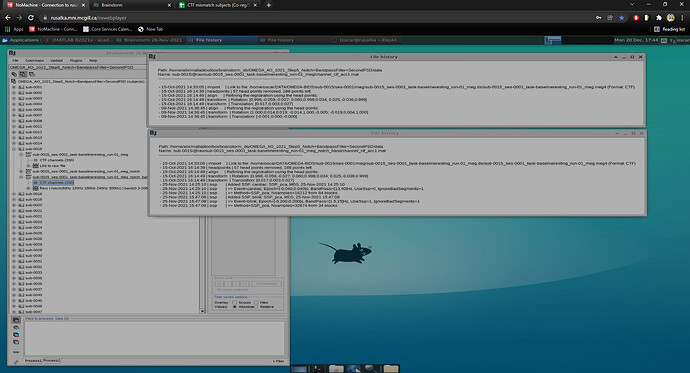Hi guys,
My colleague and I are working with the OMEGA dataset and we just realized that we made a mistake a few weeks ago during MEG data pre-processing. Basically, for some subjects we made minor last-minute changes to the co-registration (such as adjusting background threshold, adjusting erode factor...) and re-refined the registration on the original, raw, CTF file, instead of applying those changes directly to the CTF file of the notched-and-bandpassed-filtered folder. The problem is that we then computed SSP projectors on the notched+bandpassed data, which means that there is a mismatch between the two version of the CTF channel file. Here's an example of what I mean to illustrate:
Here I have Right-clicked on both CTF channel files to reveal the file history for each. The top panel reflects the history of changes made to the CTF channel file contained in the raw data folder, whereas the bottom panel reflects the history of changes made to the CTF file of the filtered data. As you can see we made some edits on November 9th which of course did not carry over onto the second version of the CTF file. Then, as you can see, we computed SSPs on the latter file, so there is a mismatch of information across these two file histories.
We were told that it's better to not copy the original CTF file onto the filtered data folder to replace the existing one, as this could corrupt the data further down the line. Instead, we were told to delete the notched and notched+bandpassed folders, re-filter the data using the raw data with the new edits to the co-registration, and finally to compute the SSP projectors all over again. The problem with that idea is that we also marked several bad segments in the filtered data, which we would of course lose.
So, my question is simple: can't we simply open the second CTF file contained in the filtered data folder (notch+bandpassed) and apply the same last-minute changes to the co-registration in this second file? I guess that we would have to re-check the already existing SSP projectors after this step, but would this work, or is it the case that we would have to re-compute the SSPs all over again?
I hope that makes sense! Thanks in advance for your time.
Best,
Oscar
